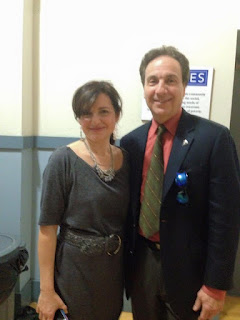 |
Pictured, an HoLa math class. HoLa Charter School announced
a new raffle method, giving priority to low-income children,
on Wednesday. (Laura Herzog | NJ Advance Media for NJ.com) |
HOBOKEN — Barbara Martinez, the board president of Hoboken's K-8 Spanish and English bilingual education charter school HoLa, was a straight-A student at Newark public schools before she headed to New York University.
"When I got to college after going through Newark public schools, I nearly flunked out (the first year) because I was so unprepared," she recalled. "I didn't know I was unprepared until I got to college."
Though she did graduate and eventually became an editor and reporter at The Wall Street Journal until 2011, she said, "I was lucky, but in this country only 13 percent of Hispanic students graduate from college."
HoLa announced Wednesday that
the state recently approved its plan to make its Jan. 15 admission lottery favor low-income students, like Martinez once was, for the first time. It's a move HoLa officials believe could help end the cycle of poverty.
Red Bank Charter School in Monmouth County also announced this week that it will also ask the state for permission to hold a weighted enrollment lottery.
For the past two years, charter schools involved in universal enrollment in Newark have already had a weighted lottery for students qualifying for free lunch, according to state Department of Education spokesman Michael Yaple. HoLa, he said, is "the first charter school to independently be granted a waiver outside of Newark's district-wide lottery system."
It's a notable shift for charters, publicly funded and independently operated schools that critics
have argued tend to serve fewer economically disadvantaged students than the traditional public schools in the same communities.
On Wednesday, HoLa officials argued that they already have diversity mirroring Hoboken's population, but want to do even better.
"After three years of trying to get approval by the New Jersey Department of Education, we are delighted to be able to finally offer low-income families in Hoboken an additional opportunity to attend our school," said Founder and Executive Director of HoLa Jennifer Sargent.
New Jersey's largest teachers union, the New Jersey Education Association, has been calling for charter schools to make sure they have all types of students, spokesman Steve Baker said.
"One of our big concerns with some charter schools has been that they don't always serve a representative student population that reflects the community why they are located," he said.
For HoLa's lottery, a public and audited event, the school assigns numbered cards to applicants, officials said. Those cards then go in a box and are randomly chosen, officials said. This year, students from low-income families (those either in Hoboken public housing, Section 8 housing; or with a child or guardian qualifying for SNAP/TANF benefits; or already qualifying for public school free or reduced price lunch) will get two cards instead of one, Martinez said.
President and CEO of the The New Jersey Charter Schools Association Nicole Cole said in a statement that her organization "fully supports Hoboken Dual Language Charter School in their tireless effort to ensure that every student in Hoboken has equitable access to an excellent education."
"HoLa is a pioneer in pursuing the weighted lottery," she said.
"I am proud of the work that our charters are doing to bring choice to Hoboken families," said Mayor Dawn Zimmer. "I congratulate HoLa on this historic step to make sure all families in Hoboken are aware of their school choices."
HoLa, which opened in 2010 and provides dual Spanish and English instruction in all subjects to about 400 students, most of whom officials said speak English at home, has previously faced opposition from some members of the Hoboken school board.
Hoboken Superintendent Christine Johnson has not yet responded to a request for comment on the move, but some locals argue it could have a big impact.
"Study after study after study tells us that the cycle of poverty is broken by high-quality education," Martinez said.
HoLa parent David Celiberti, a psychologist who works with underserved students in rural communities, noted that HoLa parents have been going into public housing for years to tell parents about HoLa.
"I am a big proponent of ensuring that everyone has access," he said. "We live in a really big diverse world and I want my son to be exposed to the full array of people who make up his community. I think that's what makes Hoboken such a great place."
Reporting contributed by Adam Clark.










